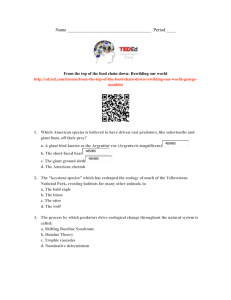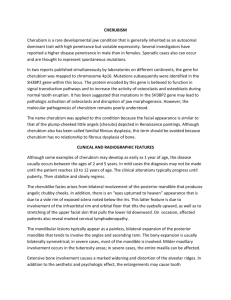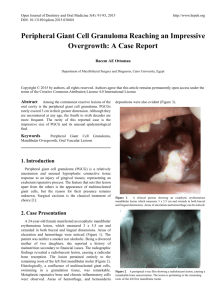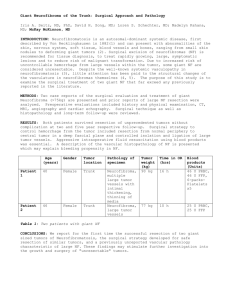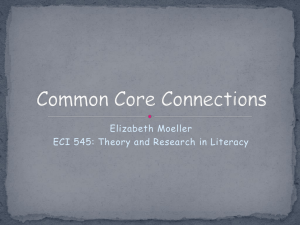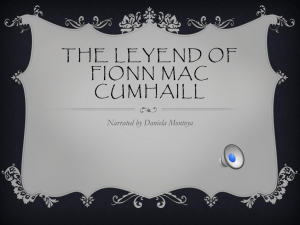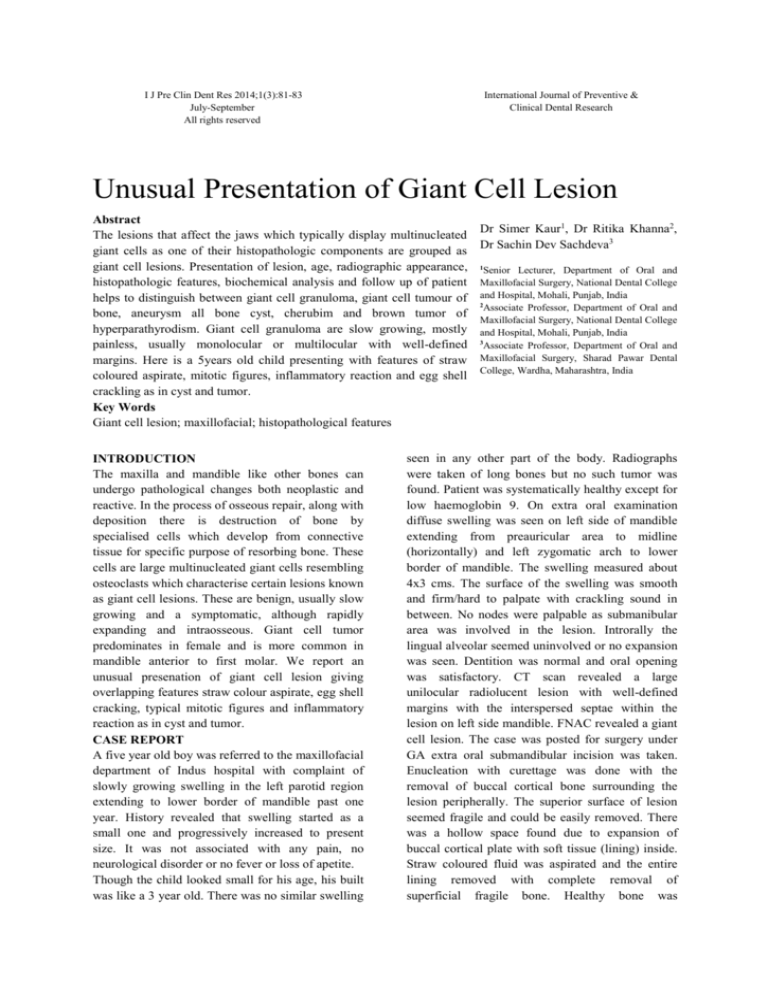
I J Pre Clin Dent Res 2014;1(3):81-83
July-September
All rights reserved
International Journal of Preventive &
Clinical Dental Research
Unusual Presentation of Giant Cell Lesion
Abstract
The lesions that affect the jaws which typically display multinucleated
giant cells as one of their histopathologic components are grouped as
giant cell lesions. Presentation of lesion, age, radiographic appearance,
histopathologic features, biochemical analysis and follow up of patient
helps to distinguish between giant cell granuloma, giant cell tumour of
bone, aneurysm all bone cyst, cherubim and brown tumor of
hyperparathyrodism. Giant cell granuloma are slow growing, mostly
painless, usually monolocular or multilocular with well-defined
margins. Here is a 5years old child presenting with features of straw
coloured aspirate, mitotic figures, inflammatory reaction and egg shell
crackling as in cyst and tumor.
Key Words
Giant cell lesion; maxillofacial; histopathological features
INTRODUCTION
The maxilla and mandible like other bones can
undergo pathological changes both neoplastic and
reactive. In the process of osseous repair, along with
deposition there is destruction of bone by
specialised cells which develop from connective
tissue for specific purpose of resorbing bone. These
cells are large multinucleated giant cells resembling
osteoclasts which characterise certain lesions known
as giant cell lesions. These are benign, usually slow
growing and a symptomatic, although rapidly
expanding and intraosseous. Giant cell tumor
predominates in female and is more common in
mandible anterior to first molar. We report an
unusual presenation of giant cell lesion giving
overlapping features straw colour aspirate, egg shell
cracking, typical mitotic figures and inflammatory
reaction as in cyst and tumor.
CASE REPORT
A five year old boy was referred to the maxillofacial
department of Indus hospital with complaint of
slowly growing swelling in the left parotid region
extending to lower border of mandible past one
year. History revealed that swelling started as a
small one and progressively increased to present
size. It was not associated with any pain, no
neurological disorder or no fever or loss of apetite.
Though the child looked small for his age, his built
was like a 3 year old. There was no similar swelling
Dr Simer Kaur1, Dr Ritika Khanna2,
Dr Sachin Dev Sachdeva3
1
Senior Lecturer, Department of Oral and
Maxillofacial Surgery, National Dental College
and Hospital, Mohali, Punjab, India
2
Associate Professor, Department of Oral and
Maxillofacial Surgery, National Dental College
and Hospital, Mohali, Punjab, India
3
Associate Professor, Department of Oral and
Maxillofacial Surgery, Sharad Pawar Dental
College, Wardha, Maharashtra, India
seen in any other part of the body. Radiographs
were taken of long bones but no such tumor was
found. Patient was systematically healthy except for
low haemoglobin 9. On extra oral examination
diffuse swelling was seen on left side of mandible
extending from preauricular area to midline
(horizontally) and left zygomatic arch to lower
border of mandible. The swelling measured about
4x3 cms. The surface of the swelling was smooth
and firm/hard to palpate with crackling sound in
between. No nodes were palpable as submanibular
area was involved in the lesion. Introrally the
lingual alveolar seemed uninvolved or no expansion
was seen. Dentition was normal and oral opening
was satisfactory. CT scan revealed a large
unilocular radiolucent lesion with well-defined
margins with the interspersed septae within the
lesion on left side mandible. FNAC revealed a giant
cell lesion. The case was posted for surgery under
GA extra oral submandibular incision was taken.
Enucleation with curettage was done with the
removal of buccal cortical bone surrounding the
lesion peripherally. The superior surface of lesion
seemed fragile and could be easily removed. There
was a hollow space found due to expansion of
buccal cortical plate with soft tissue (lining) inside.
Straw coloured fluid was aspirated and the entire
lining removed with complete removal of
superficial fragile bone. Healthy bone was
82
Giant cell lesion
Kaur S, Khanna R, Sachdeva SD
Fig. 1: Preoperative lesion
Fig. 2: Intraoperative
Fig. 3: Intraoperative
Fig. 4: Immediately after surgery
Fig. 5: 1 week postoperative
preserved below the fragile bone and lingual
cortical bone was kept intact. A drain was put and
surgical site was closed in layers. No recurrence
seen 2 years post op. The serum chemistry of
calcium, phosphorous, parathyroid hormone was
normal, there by excluding the possibility of
hyperthyroidism
and
brown
tumor.
Histopathological
examination
of
biopsied
specimen revealed connective tissue made up of
mature collagen fibres, fibroblasts, typical mitotic
figers, inflammatory reaction and showing
numerous multinucleate giant cells with foci of
osseous structures with no malignant cells.
DISCUSSION
Giant cell lesions include neoplasias, hyperplasias
and dysphasias. Distinction between these entities is
difficult to make by means of microscope alone.
Giant cells lesions account for 6.6% lesions of the
jaw. These are either endosteal or periodsteal.
Though rare in occurrence in the jaw these lesions
have been a source of debate. Majority designated
as giant cell reparative granuloma are benign, slow
growing and have favourable prognosis. It is
essential to differentiate these lesions which
represent a reparative inflammatory process from
aggressive giant cell tumor of jaw. Radiographic
appearance of giant cell lesion is variable. Usually
unilocular or multilocular with well or I'll defined
margins showing variable expansion and destruction
of the cortical plates. Root resorption and cortical
perforation with loss of dental lamina dura may
occur. Microscopically there is presence of few to
many multinucleated giant cells in a background of
ovoid to spindle shaped mesenchymal cells in
variable amount of hemosiderin. Laboratory
findings are necessary to reach to definitive
diagnosis. Blood serum and urine tests for calcium
and phosphorous values are important in excluding
the diagnosis of giant cell lesion of
hyperparathyroidism. For early diagnosis and
management microscopic findings must be
correlated with clinical, radiographic and laboratory
information.
CONCLUSION
Having the overlapping features we distinguished
giant cell granuloma from aneurysmal bone cyst and
giant cell tumor on basis of no aspiration of blood,
slow growing lesion with no recurrence of lesion in
5 years, presentation of lesion at 5 years with
unaltered mental health, presence of hemosiderin,
volume and type of giant cells and unaltered serum
levels of calcium and phosphorous.
83
Giant cell lesion
REFERENCES
1. Abrams B, Shear M. Estimation of the
volumes of multinucleated giant cells. J Oral
Pathol 1977;6:264-7.
2. Betaineb AB, Al- Khateeb T, Rawashden MA.
The surgical treatment of central giant cell
granuloma of the mandible. J Oral Maxillofac
Surg 2002;60:756-61.
3. Sachdeva SD, Misurya R, Bagdi A.
Hemifacial Atrophy - A case report. JDMIMS
2006;2:99-102.
4. Bertoni F, Unni KK, Beabout JW. Giant cell
tumor of the skull. Cancer 1992;70:1124-32.
5. Averill RM, Smith RJ, Campbell. Giant - cell
tumors of the bones of the hand. J Hand Surg
Am 1980;5:39-50.
6. Austin LT, Dahlin DC, Royer RQ. Giant cell
reparative granuloma and related conditions
affecting the jaw bones. Oral Surg Oral Med
and Oral Pathol 1959;11:1285.
7. Cran JA. Giant - cell reparative granuloma of
the mandible. Br J Oral Surg 1967:16-19.
8. Som PM, Lawson W, Cohen BA. Giant cell
lesion of the facial skeleton. Radiology 1983;
147:129-34.
Kaur S, Khanna R, Sachdeva SD

